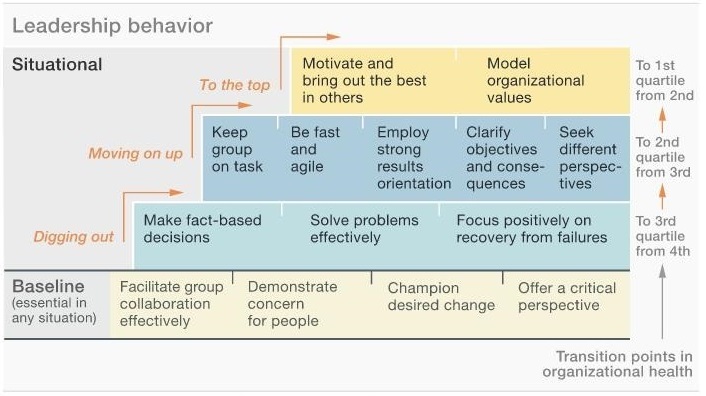What are the leadership styles that equal success? Which ones will help you move the company forward? Who are the great leaders you should be emulating?
If you’re looking to define the leadership styles that will make a difference in your company, or to your career, choose carefully. Making the wrong choice can doom both.
It would seem to make sense that picking a successful leader and emulating the traits that helped them succeed will provide similar results for your company. Or at least make you a more successful leader.
According to a study done by McKinsey & Company, though, the real key to success depends on matching leadership behaviors to the health of the company.
The McKinsey study was trying to figure out if there was a type of leader, or set of leadership styles, that delivered the best results. What they found, in the study of 375,000 people in 165 companies, was that which leadership behaviors worked best depended upon the health of the company.
They surveyed individuals about their companies’ health and the effectiveness of a group of leadership behaviors. What they came back with was a model they likened to Maslow’s hierarchy of needs. Each level of organizational health has a list of leadership traits that are necessary to master in order to evolve to the next level of health. At the bottom was a list of what they called “baseline behaviors” that are necessary at any organization, regardless of level of health.

Exhibit from “Leadership in context”, January 2016, McKinsey Quarterly, www.mckinsey.com. Copyright (c) 2016 McKinsey & Company. All rights reserved. Reprinted by permission.
We discussed our own research on the subject and that of the Human Capital Institute in our blog post Do We Need a Different Type of Leader.
Don’t Try to be the Next Richard Branson
A common mistake companies make is looking to bring in a leader who was successful somewhere else without enough thought of why they succeeded. The thinking being that if this person can bring the kind of leadership that worked at Company X, it will help us get to the top. The authors of the study found that the opposite was actually true in most cases.
Imagine if you brought in Richard Branson, or found an executive with Branson-like behaviors, to lead your company. He hit the road and began championing the organizational values and motivating people to embrace his vision of the future. Sounds pretty good. But, if your company is in what the authors call the “digging out” phase, and what you really need is a leader who can make fact-based decisions, solve problems effectively, and focus positively on recovery from failures, his actions won’t get you there.
In the article in the McKinsey Quarterly unveiling the research, the authors present an example of a newly-merged organization that had a new, charismatic leader. He traveled the world espousing the vision and promising “jobs for everyone.” Unfortunately, the organization relied too heavily on his charisma and not enough on the detailed work of integrating two companies. As a result, the new organization struggled and issued mass layoffs. This killed the leader’s credibility and eventually the merger dissolved.
How Do You Choose the Right Kind of Leader?
Finding the right kind of leader is critical to the success of a company. As the McKinsey research has shown, the kind of leadership you need varies based on the health of the company and other factors. That may be why, in our McQuaig Global Talent Recruitment Survey, only 25% of HR professionals rated their leaders as “very effective.”
If we accept the McKinsey findings, then the path to finding the right kind of leader will begin with understanding the health of your company; what behaviors are required to move you to the next level; and who inside or outside your company has those traits. It might look something like this:
Determine the health of your company. There are many ways to do this, but you basically have to figure out how effective the company is in key areas like innovation, accountability, culture, leadership, etc. One of the authors of the McKinsey study has created something called the Organizational Health Index. You can take a free assessment on their website to gauge the health of your organization.
Identify which behaviors you need. Once you know where you are, you need to figure out which leadership behaviors will move your company to the next level. You can use the behaviors identified in the McKinsey study, or you can determine your own. This is what we do with many of our clients using leadership assessments to set targets for leadership candidates.
Find and develop people with the right behaviors. Look inward to find the people in your company with the potential to master the behaviors you now know you need. Then create development plans for them. If you need to, look externally for those same behaviors. This work can be made a lot easier if you’re using an assessment tool that provides you with a level of fit assessment to the leadership profile you’ve created.
And remember, this isn’t a one-time exercise. Your leadership needs will change as your company’s level of health and the market changes. Always be aware of your level of health and the behaviors you need your leaders to have. And always be identifying and developing people who can become the leaders you’ll need.
You can read the complete McKinsey Quarterly article here.
How do you know what type of leadership you need?
{{cta(‘9df0b391-809f-482f-baa0-2c2aaa43636a’)}}





Aydan Yalcinkaya
Leadership